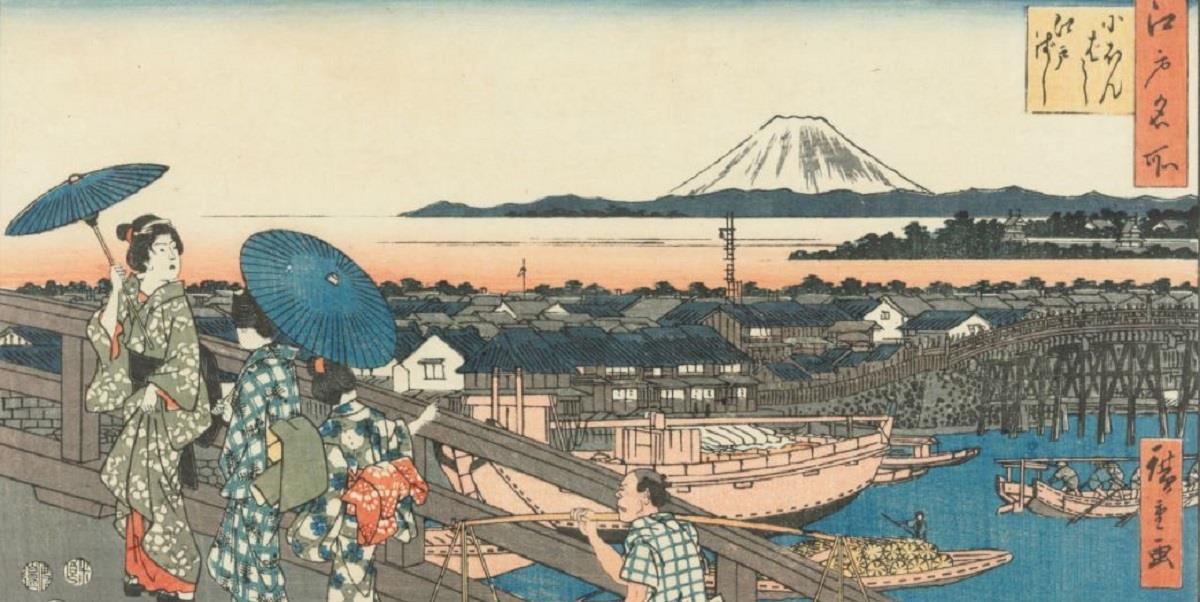In the mid-19th century, Edo — modern-day Tokyo — was the most populous city on earth. During the longest period of peace in Japan’s history, the ruling Tokugawa shogunate had established a new order under which artists flourished amid growing prosperity. Yet the country had been cut-off from the outside world for two centuries, almost entirely erased from the Western imagination.
A particularly splendid creation of the Edo period (1615-1868) was the art of Japanese woodblock printing known as ukiyo-e, or ‘pictures of a floating world’. Marked by a visual language of unusual viewpoints, abrupt cropping, exquisite stylisation and patches of vivid colour, it developed around 1765 and remained popular to the last decades of the Meiji period (1868-1912). Among its masters are some of the greatest artists of all time: Kitagawa Utamaro, Katsushika Hokusai and Utagawa Hiroshige.
In March, Christie’s Education will present A Journey Through the Floating World: How to Look at Japanese Woodblock Prints, a short course focusing on the materials, innovations and themes of ukiyo-e. The programme is led by art lecturer and museum educator Karly Allen, whose work as co-founder of Limina Collective has brought mindfulness approaches and meditation in the Japanese Zen tradition to museum workshops. Subjects addressed in the course include the interpretation of signs, symbols and narratives in ukiyo-e, its impact on Western art, and why its masterpieces became the iconic images we know today.
Ukiyo-e was not always regarded as ‘high’ art. ‘Ukiyo’, the Buddhist notion of impermanence, was adopted and secularised to become the ‘floating world’ of transient pleasures offered in the theatres, teahouses and brothels of Japan’s great cities. These entertainment districts attracted a growing merchant class, turned its courtesans and actors into celebrities, and made the printmakers who captured their portraits part of a vast artistic endeavour.
The huge popularity for ukiyo-e was met by increasingly sophisticated techniques like full-colour printing, which allowed artists to produce subtle effects like the shifting tones of Hiroshige’s sunsets and expanses of water. An easily reproduced medium, the prints were a relatively cheap form of art for those unable to afford Japanese paintings.
The range of subjects and styles of ukiyo-e was extraordinary. Utagawa Kuniyoshi (1798-1861) brought drama, dynamism and imagination to the medium with his illustrated exploits of legendary heroes, while Hiroshige’s epic One Hundred Famous Views of Edo represents the style’s greatest achievement in landscape art. The best-known image of the floating world is Hokusai’s The Great Wave off Kanagawa, one of the most reproduced artworks in the world. The wave itself is coloured in Prussian blue, a synthetic dye invented in Europe that points — alongside the artist’s use of linear perspective — to the embryonic artistic dialogue between Japan and Europe.
The West’s leading enthusiasts for ukiyo-e were the French impressionists, who had first fallen in love with the labels on cases of tea imported from Yokohama. Paul Gauguin, Vincent van Gogh, Henri de Toulouse-Lautrec, Claude Monet and James McNeill Whistler found in Japanese woodblock art a new idiom of flattened perspective, arrangement of forms and emphasis on mood. In 1903, Camille Pissarro wrote to his son Lucien about a show of prints by Utamaro and Hiroshige in Paris: ‘The Japanese exhibition is magnificent: Hiroshige is a wonderful impressionist. Monet, Rodin and I are enthusiastic. How glad I am to have painted the effects of snow and floods; these Japanese artists have confirmed us in our visual judgement.’

